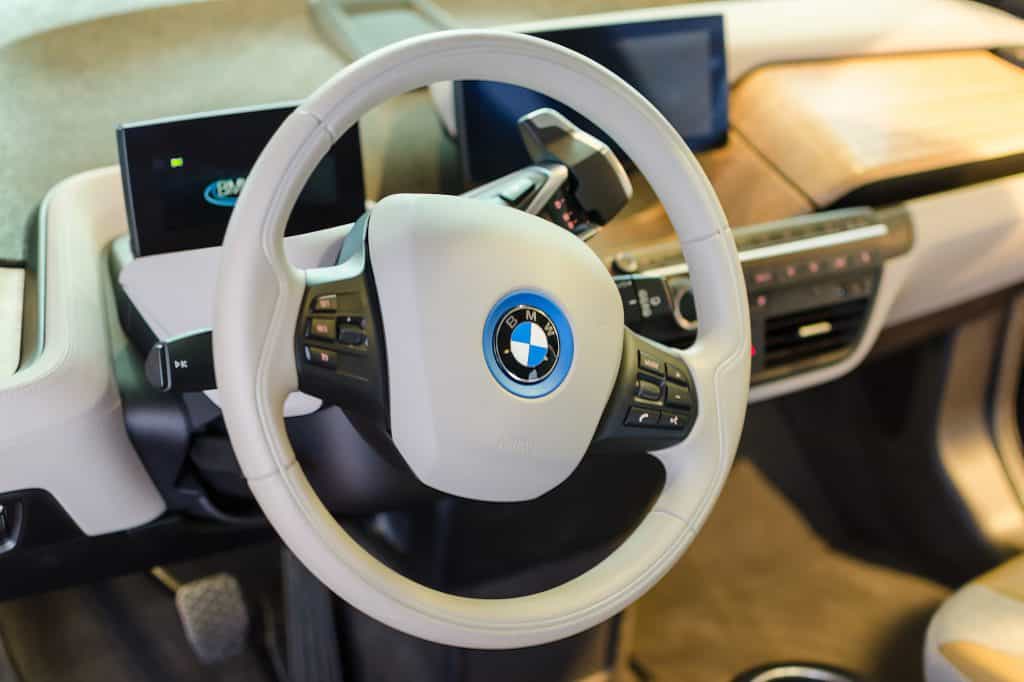If you’ve ever looked at BMW i3 models in a dealership or online, have you ever wondered why some of them are called i3 and others are called i3 REx? What is this “REx” that we see tagged on the end? Is there something particularly dinosauric about this version of the i3? Is there some reason to suspect it’s a relic from 65 million years ago? Alas, no, it’s nothing quite so exotic.
The “REx” addition refers to the car’s “Range Extender,” and that’s going to be the focus of today’s blog post. What is the range extender? How does it work? What are the pros and cons of adding to an i3? Furthermore, how do you know if you’re getting an i3 with a range extender if you buy a used model?
What is the BMW i3 Range Extender? How Does It Work?

Put simply, the BMW range extender was a 2-cylinder gasoline combustion engine that was added to the BMW i3 in order to provide additional charging power for the batteries. Contrary to popular belief, the range extender was not a separate engine used to power the car when the batteries go dead. In fact, it wasn’t connected to the wheels at all. It was classed by BMW as an auxiliary power unit (APU), the primary function of which was to extend the range of the vehicle only (as the name suggests).
The range extender acted as a charging mechanism for the batteries, providing charging capabilities much more like a hybrid car than a traditional electric vehicle. With the range extender installed and working properly, drivers of the BMW i3 could enjoy up to 80 miles more range when in Comfort mode.
The way it works is fairly straightforward. When your BMW i3 main battery starts to get low, the range extender kicks in to maintain the battery level as long as possible and allow the car to keep travelling at the same pace.
The owner can add gas to the engine as you would do with a regular gasoline car, but it must be stressed that this small added engine will never give any power to the wheels, nor does it make it a hybrid car like a Toyota Prius. In a Prius, the combustion engine propels the car and recharges the electric powertrain, but in the i3, it is exclusively used to maintain charge in the electric powertrain.
Do All BMW i3 Models Have the Range Extender?
Not all BMW i3 models have a range extender, no The range extender was added to the 2014 i3 model with the 60Ah battery option. It was added to the 94Ah battery option in 2017, and then to the 120Ah battery option in 2019. You can easily see if your own BMW i3 has the range extender in two ways:
- Firstly by looking at the exterior on the driver’s side. There should be a fuel flap located on the front driver’s side of the car.
- On top of that, you can confirm further by looking at the fuel gauge on your instrument cluster, which should display both the amount of electrical charge that you have, and the amount of fuel in the gasoline tank.
Both the European and US versions of the i3 REx featured a 9-litre (2.38-gallon) gasoline tank, but the US version had a software restriction which limited the supply of gasoline you could put in the tank to 7.2 litres (1.9 gallons). It wasn’t until the 2017 model year, however, that the US version of the BMW i3 REx could get up to 180 miles or more according to the EPA test cycle ratings. Before that, the range was consistently lagging behind that of the European model.
You’d certainly know if you had the range extender when you bought the i3, however, because it added a lot to the cost — as well as extra weight, which we’ll discuss in the pros and cons section — about
Pros and Cons of the Range Extender

The merits and problems with the range extender are much discussed in the BMW driver community and even beyond. Certain problems with the REx models have even led to class-action lawsuits being filed against BMW, so there are obviously strong arguments on both sides.
Pro – Additional Range
Most obviously, the main benefit of the technology is to add range to the BMW i3m which in itself is a fairly low-range car when compared to some of the premium competition they have, especially from the likes of Tesla. You actually spend less ($39,900) for an entry-level Tesla Model 3 with more range (220 miles as standard) and power, (0-60 acceleration in 3.1 seconds), than you would for a 2021 model year i3 ($44,450).
Therefore, the range extender makes the i3 better value for money since you get a more competitive range. It helps people take the i3 out of the city and into the rural and suburban arena, and changes it from a pure commuting/city car into something more versatile.
Pro – Safety Net
The REx unit gives you an added safety net thanks to the additional range you get. If you find yourself low on battery, perhaps after discovering a charging station you were directed to was out of service or broken down, for instance, then the REx unit can at least help you get to another charger, or perhaps the whole distance home where you can plug in as normal. It’s good to have the added reassurance.
Pro – Extra Value on Car
If you were to resell the car, one that had the REx unit installed would likely fetch a higher price and retain value better. Range anxiety is a real problem among both prospective and current EV owners and drivers, so anything that can promise range extension has intrinsic value.

Con – Additional Weight and Cost
The REx unit adds an extra 264lbs of weight to the vehicle, which is heavy enough with its battery pack and everything else at 2,635lbs. That goes up to 2,899lbs with the range extender added to it. Extra weight actually means diminished performance in some ways (we’ll talk more about that below).
Furthermore, the range extender adds a lot to the price. While the regular model starts at just under $45,000, the REx model goes up to $48,300, or even $51,500 depending on the exact specification you choose. That’s a lot of extra cost when you think that you could get a car with inherently more range like the Tesla Model 3 for under $40,000.
Con – Sudden Speed Limitations
Some owners have reported that while travelling in range-extending mode on slopes or hills, that the car suddenly slowed to 45mph until getting back onto flat or downhill roads again. This may sound nothing but a slight annoyance, but the same problem also occurred with some drivers on the highway without warning.
If you’re traveling along at 60-65mph and then suddenly are forced to drive at 45mph on a highway, that is very noticeable, and potentially dangerous.
This problem even led some owners to lead a class-action lawsuit against BMW for the sudden drops in speed, which they blamed on the car’s design. The lawsuit eventually amounted to nothing and was dismissed in March 2021.
Fans of the i3 of course insist they’ve never experienced the issue, but it’s hard to believe that so many people just made up the problem, and so it could conceivably happen to others.
Conclusion: Fate of the BMW Range Extender
In the North American and Japanese markets, the range extender continues to be offered as an option because of higher demand. In Europe, the range extender was dropped back in 2019-2020 because the new generation of batteries coming in on the i3 models were offering essentially what the range extender could, so it was felt the extra option (and expense) were no longer justified.
As we mentioned above, the range extender does add considerable cost to the i3. The i3 REx (0-60 in 8.3 seconds) starts at $48,300, and the 2021 i3s REx (0-60 in 7.6 seconds) goes up to $51,500.